Baby Emerald Tree Boa | emerald tree boa | Best 5
$799.99
Baby Emerald Tree Boa | emerald tree boas for sale | Best 5 boas snakes for sale | Baby Emerald Tree Boa for sale | emerald tree boa adaptations
Baby Emerald Tree Boa: A Complete Guide for Reptile Enthusiasts
The baby emerald tree boa is one of the most stunning and fascinating snakes in the reptile world. With its striking green coloration, graceful climbing ability, and unique body structure, this species has become a favorite among reptile lovers. Known for its captivating appearance and sometimes vibrant hues, including rare color morphs like *purple baby emerald tree boas*, this snake offers an exotic pet option for dedicated and experienced keepers.
If you’re considering adding a *baby emerald tree boa for sale* to your collection or just want to learn more about this remarkable species, this guide will provide everything you need to know. From understanding their natural habitat and behaviors to learning how to care for them in captivity, you’ll be well-equipped to provide a healthy and enriching environment for these snakes.
Understanding the Emerald Tree Boa
Natural Habitat and Range
The emerald tree boa (Corallus caninus) is native to the rainforests of South America. It can be found in countries like Brazil, Colombia, Venezuela, and parts of the Guianas. This species thrives in tropical, humid environments, where they can be seen coiled on branches of trees, displaying their vibrant green coloration which camouflages perfectly among the leaves.
Emerald tree boas are arboreal, meaning they spend most of their time in trees. Their slender bodies, long tails, and hook-like teeth are perfectly adapted for a life above the ground, making them exceptional climbers. In the wild, these boas hunt small mammals, birds, and other prey by ambushing them from the branches.
Size and Lifespan
Emerald tree boas are medium-sized snakes, with adults reaching lengths of around 6 to 9 feet. However, *baby emerald tree boas* are much smaller at birth, typically measuring around 12 to 16 inches long. These babies grow rapidly in their first few years, eventually reaching their full adult size over a period of 4-5 years.
In captivity, emerald tree boas can live for up to 20 years with proper care. Their long lifespan makes them a long-term commitment for any reptile enthusiast, so it’s important to be well-prepared for the responsibility of caring for them.
Unique Features of the Baby Emerald Tree Boa
One of the most fascinating aspects of the emerald tree boa is its color transformation as it grows. *Baby emerald tree boas* are not born with the vibrant green coloration that adults are known for. Instead, they are typically born in shades of orange, red, or yellow. This juvenile coloration provides camouflage among the forest floor or lower branches where young boas spend their time before moving up into the trees as they mature.
As they grow, their color gradually changes to the brilliant emerald green that adults display. This color change usually begins around 6 months of age and can take several years to complete. The shift in color is thought to coincide with their movement from lower forest levels to higher canopy habitats.
One of the rarest and most sought-after variations is the *purple baby emerald tree boa*, a morph that displays beautiful purple hues instead of the usual red, orange, or yellow. These color morphs are exceptionally rare and can command a high price due to their unique appearance.
Baby Emerald Tree Boa for Sale: What to Know Before Buying
If you’re in the market for a *baby emerald tree boa for sale*, there are a few things you should consider before making your purchase. These snakes are not beginner reptiles, and their care requirements can be more demanding than other species. However, for experienced reptile keepers, they offer a rewarding and visually stunning addition to any collection.
Purchasing from Reputable Breeders
When searching for *emerald tree boas for sale*, it’s crucial to purchase from a reputable breeder who specializes in this species. Baby emerald tree boas are delicate and can be prone to health issues if not properly cared for from birth. Reputable breeders will ensure that the baby boas are feeding well, properly hydrated, and free from parasites before selling them.
Ask the breeder about the snake’s health history, feeding habits, and any genetic information available, especially if you’re interested in rare color morphs like the *purple baby emerald tree boa*. Reputable breeders will also provide you with guidance on caring for the snake, ensuring you’re fully prepared for the challenges and responsibilities of ownership.
Baby Emerald Tree Boa Price
The price of a *baby emerald tree boa* can vary significantly depending on the snake’s lineage, coloration, and age. Standard baby emerald tree boas can range from $300 to $800, while rare color morphs like the *purple baby emerald tree boa* can command prices well over $1,000. The price also depends on whether the snake is captive-bred or wild-caught, with captive-bred boas being the preferred and often more expensive option due to their higher likelihood of being healthy and well-adjusted to captivity.
While it may be tempting to purchase a cheaper wild-caught snake, it’s important to note that these snakes often come with health problems, including parasites or stress-related illnesses. Wild-caught boas may also be more difficult to acclimate to captive life, so it’s always best to invest in a healthy, captive-bred animal.
Housing Your Baby Emerald Tree Boa
Providing a proper habitat for your *baby emerald tree boa* is essential to ensure its health and well-being. Because these snakes are arboreal, their enclosure should mimic their natural environment as closely as possible. Here are some key aspects to consider when setting up their home.
Enclosure Size and Type
For a *baby emerald tree boa*, a smaller enclosure is suitable until they grow larger. A 20-gallon vertical terrarium or a similarly sized enclosure is ideal for babies, as it provides enough space for climbing and thermoregulation without being too large, which can stress the snake. As the snake matures, you will need to upgrade to a larger enclosure, with adult boas requiring at least a 3’ x 2’ x 2’ enclosure.
Vertical space is more important than floor space, as emerald tree boas spend most of their time off the ground. Provide plenty of branches, perches, and vines for the snake to climb on and coil around. Use sturdy branches that can support the snake’s weight, and arrange them at different heights to encourage natural climbing behavior.
Temperature and Humidity
Maintaining the proper temperature and humidity is critical for the health of your *baby emerald tree boa*. These snakes thrive in warm, humid environments, similar to their native rainforest habitat.
– *Temperature*: The ambient temperature in the enclosure should be kept between 75-80°F, with a basking spot that reaches around 85-88°F. Use a thermostat to control the heat source, and avoid overheating the enclosure, as emerald tree boas are sensitive to high temperatures.
– *Humidity*: High humidity levels are crucial for the health of your baby boa. Aim for a humidity level of 70-80%, and provide regular misting to maintain moisture in the enclosure. Installing a humidity gauge will help you monitor the levels accurately. Additionally, including a water dish large enough for the snake to soak in will help maintain proper hydration.
Substrate and Decor
Choosing the right substrate will help maintain humidity levels and provide a comfortable environment for your snake. Popular substrate options include cypress mulch, coconut fiber, and sphagnum moss. These materials retain moisture well and create a more naturalistic setting for your snake.
When it comes to decor, focus on creating a dense environment with plenty of foliage and branches. You can use live or artificial plants to provide cover and encourage climbing. Not only will this make the snake feel more secure, but it will also replicate its natural habitat.
Feeding a Baby Emerald Tree Boa
Feeding your *baby emerald tree boa* is one of the most important aspects of its care. In the wild, emerald tree boas hunt small mammals and birds, but in captivity, they can be fed a diet of appropriately sized rodents.
What to Feed
*Baby emerald tree boas* should be fed small, appropriately sized prey, such as pinky or fuzzy mice, depending on the size of the snake. Offer one prey item every 7-10 days, and be sure to feed pre-killed prey to avoid the risk of injury to the snake.
As the snake grows, you can gradually increase the size of the prey, offering larger mice and eventually small rats to adult emerald tree boas. Avoid overfeeding, as these snakes can become obese if they are fed too frequently or given prey that is too large.
Feeding Behavior
Emerald tree boas are known for their ambush hunting style. In captivity, they will usually strike from a perched position on a branch or vine, constricting the prey before swallowing it whole. It’s important to avoid handling the snake immediately after feeding, as this can cause regurgitation, a common problem in arboreal snakes.
Monitor your baby boa’s feeding habits closely. If the snake refuses food for more than two or three feedings, it may be a sign of stress, illness, or improper husbandry conditions, such as low humidity or incorrect temperatures.
Handling and Behavior of Baby Emerald Tree Boas
*Baby emerald tree boas* can be more temperamental and defensive compared to other snakes. They are known for their striking behavior, especially when feeling threatened. Handling should be kept to a minimum, especially with younger snakes, as they can become stressed easily.
Handling Tips
– *Minimize Handling*: Emerald tree boas are more of a “look but don’t touch” snake, especially when they’re young. They tend to be defensive, and frequent handling can stress them out, leading to health problems. When necessary, handle your snake gently and with care.
– *Use Snake Hooks*: When handling emerald tree boas, especially adults, it’s often best to use a snake hook to move them from one perch to another. This helps reduce stress and prevents accidental bites.
reduces the likelihood of injury to both you and the snake. If you must handle the snake directly, approach it slowly and avoid sudden movements that may provoke a defensive response.
– *Respect Their Space*: Emerald tree boas are best appreciated for their beauty and unique behavior rather than as a hands-on pet. Allow your baby boa to explore its enclosure and engage in natural behaviors without too much interference.
Common Health Issues in Baby Emerald Tree Boas
While *baby emerald tree boas* can be hardy snakes when properly cared for, they are prone to certain health issues, particularly if their enclosure conditions are not ideal. Knowing what to look for can help you prevent or address these issues early.
Respiratory Infections
Due to their need for high humidity, emerald tree boas are susceptible to respiratory infections if the enclosure is too dry or if the temperature drops too low. Symptoms of a respiratory infection include wheezing, bubbling around the nose or mouth, and open-mouth breathing. If you notice any of these signs, it’s essential to consult a veterinarian experienced with reptiles.
Parasites
Parasites, both internal and external, can affect emerald tree boas, especially if they were wild-caught or not sourced from a reputable breeder. Regular fecal exams are recommended to check for internal parasites, while external parasites, such as mites, can be spotted during routine health checks. Parasites can cause significant health problems, including poor appetite, lethargy, and skin issues.

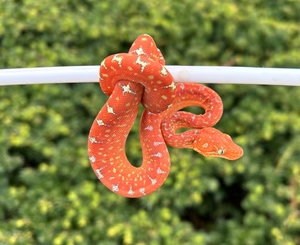
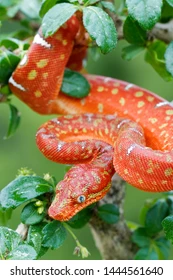
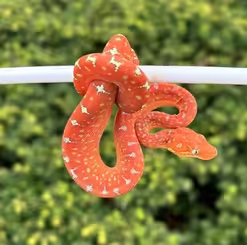
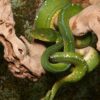
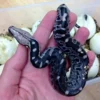
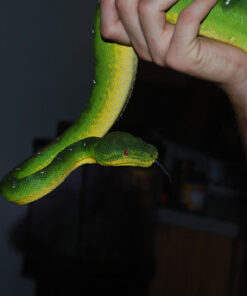

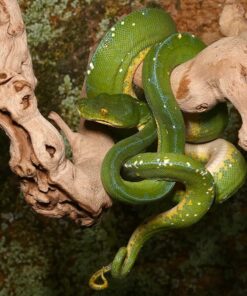
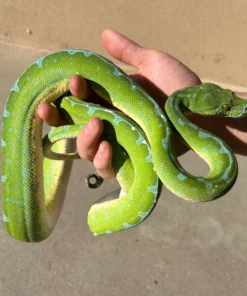
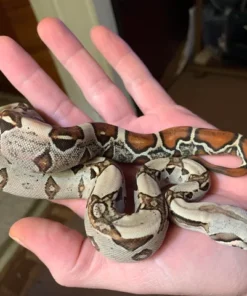
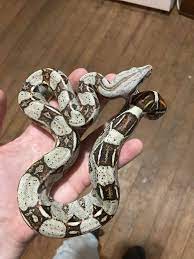
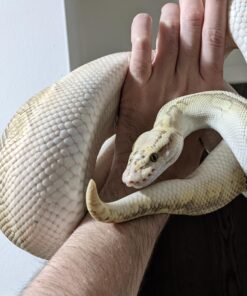

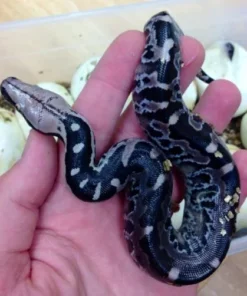

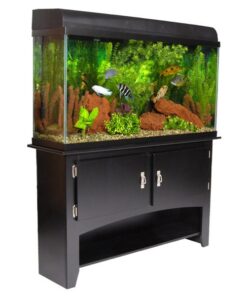
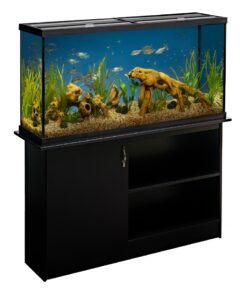
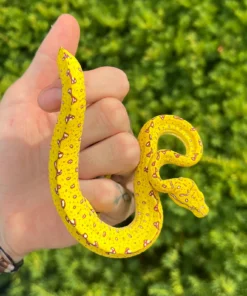


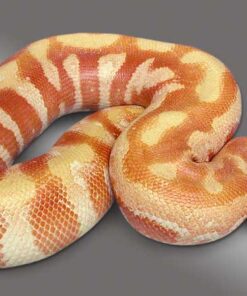
Reviews
There are no reviews yet.